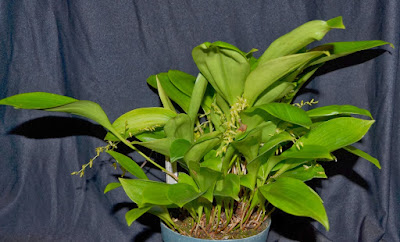Pleurothallis helleri flowers are patent, green-yellowish in color, with red patches on the lateral lobes of the lip and the callus...
Pleurothallis helleri also called as Heller's Pleurothallis, is a species of the genus Pleurothallis. This species was described by Alex Drum Hawkes in 1966.
PLEUROTHALLIS HELLERI - HELLER'S PLEUROTHALLIS DESCRIPTION
Pleurothallis helleri is native to Costa Rica, Ecuador, Honduras, Nicaragua. It is rare species and is found growing on trees in rainforests of Atlantic zone at elevations of 345-810 meters above sea level, disjunct in Nicaragua and Ecuador.
It is a small to large sized, hot growing epiphyte which reaching up to 50 cm in height with short rhizome and erect, stout, elongate, up to 35 cm long ramicauls that are enveloped by one below the middle and by 2 to 3 close tubular sheaths below. The single leaf is 20 cm long by 6 cm wide, acute and shortly acuminate at the apex, cuneate at the base, subcoriaceous.
Heller's Pleurothallis blooms in the winter from several racemose inflorescences of up to 10 cm long, including the peduncle that grows from a carinate spathe with 10 to 20 flowers. The flowers are patent, green-yellowish in color, with red patches on the lateral lobes of the lip and the callus. Sepals are acuminate, dorsally carinate; lateral sepals are connate towards the truncate apex, with four nerves. Petals are patent. Lip is fleshy, verrucose, somewhat arched; lateral lobes are thin, round and erect; midlobe is fleshy, verrucose, obtuse; disc with an elevated callus along the base of each lateral lobe. Column is short, nailed, finely papillose, with a conspicuously rounded foot.
PLEUROTHALLIS HELLERI - HELLER'S PLEUROTHALLIS CARE AND CULTURE
Cultural information should only be used as a guide, and should be to be adapted to suit you. Your physical location; where you grow your plants, how much time you have to devote to their care, and many other factors, will need to be taken into account. Only then can you decide on the cultural methods that best suit you and your plants.
Light:
Pleurothallis helleri needs a light level of 12000-18000 lux. The light should be filtered or dispersed, and the plants should not be exposed to direct sunlight in the afternoon hours. Strong air movement should be ensured all the time.
Temperature:
The average temperature of the summer day is 29 ° C, 19-21 ° C at night, and the daily difference is 8-19 ° C. The average temperature of the winter day is 29-32 ° C, the night is 14-16 ° C, and the daily difference is 13-17 ° C.
Humidity:
Heller's Pleurothallis needs the humidity of probably around 80% throughout the year. Too dry air has a negative effect on the development of the plant: its growth is inhibited, and the leaves begin to turn yellow and dry out. The higher temperature, the higher the humidity should be, and the higher the humidity, the more often and longer it is necessary to ventilate the room where the plants are contained, otherwise the probability of rotting and various kinds of fungal diseases. Good air movement is essential while the plants are in leaf and growing.
Substrate, growing media:
Pleurothallis helleri can be grown in small pots or baskets or mounted on pieces of tree ferns with peat moss pillows around the roots, with high humidity ensured and daily watering in the summer, during the dry and hot periods it may be necessary to water several times a day.
These plants are also grown in pots or baskets using a very loose, fast-drying substrate, such as fir bark or chopped tree fern fibers. Also, the materials that release the substrate but often retain a portion of the moisture, e.g. perlite, are often added to such a mixture. The addition of charcoal also improves the permeability of the substrate, and also protects against acidification.
Repotting:
Heller's Pleurothallis react badly to any manipulations, so they should be repotted or divided only when absolutely necessary. However, because these plants do not tolerate also the decaying soil around the roots, they should be repotted immediately when the substrate begins to decompose. Therefore, it is recommended to choose a substrate such as tree fern fibers, because these are slowly decomposed. If repotting is done at the time when new roots begin to appear, the plant will be accepted and rooted in the shortest possible time. If the plant was divided, it may take up to two years to recover.
Watering:
Pleurothallis helleri should be watered abundantly during the period of intensive growth from the summer to the beginning of winter, but excellent drainage should be ensured so that the ground around the roots is never desiccated or soggy.
Fertilizer:
During the active growth, Heller's Pleurothallis should be fertilized every week 1/4-1/2 of the recommended dose of fertilizer for orchids. From spring to mid-summer, you can use fertilizer enriched with nitrogen, then switching to phosphorus-enriched fertilizer in late summer and autumn.
Rest period:
Pleurothallis helleri need less water in the winter, especially if they grow under the conditions of a dark, short day that occurs in moderate latitudes. However, these plants should never be completely dried up. Fertilization should be reduced or eliminated until new growths appear and a more abundant spring watering begins.















COMMENTS